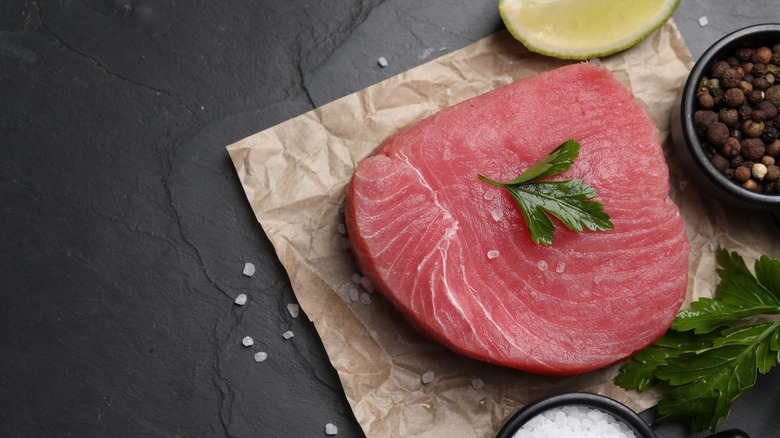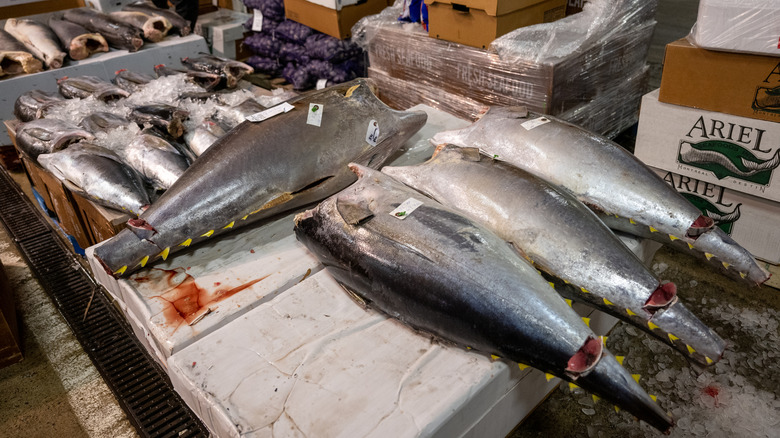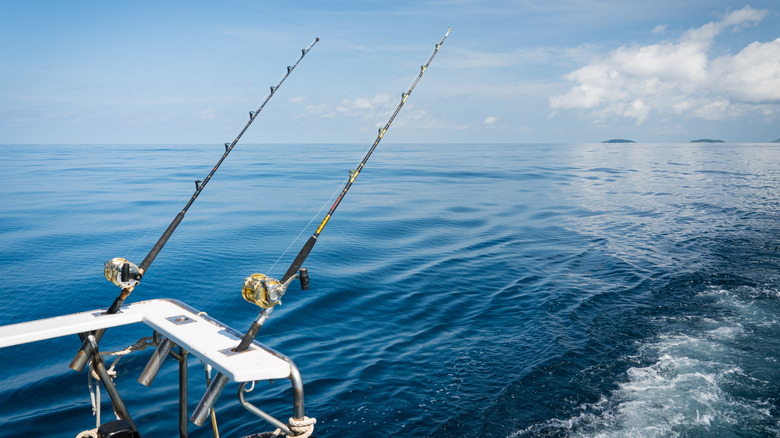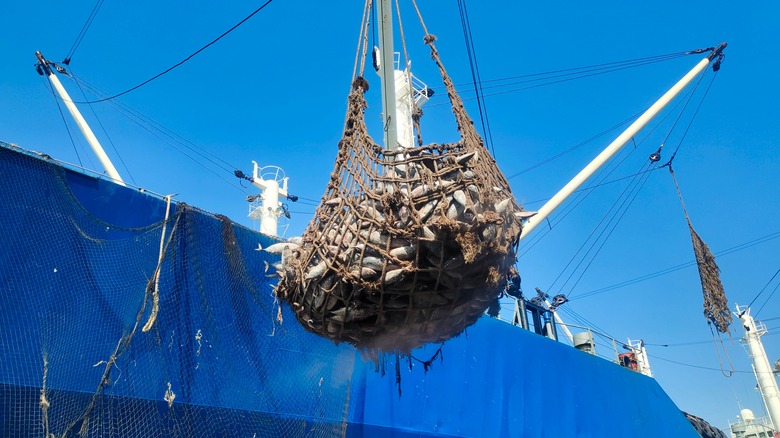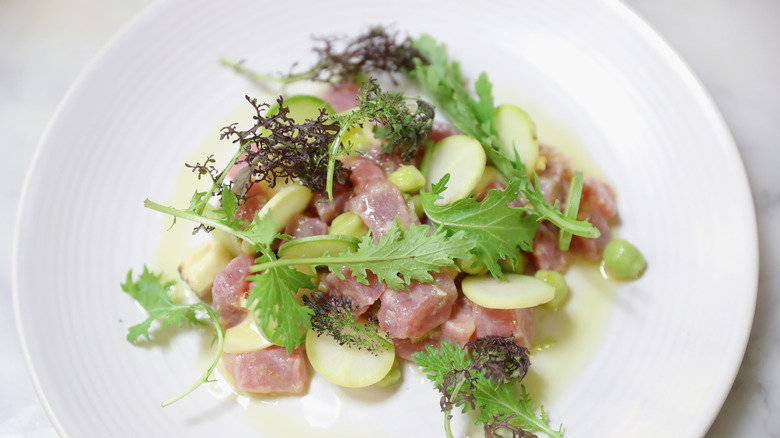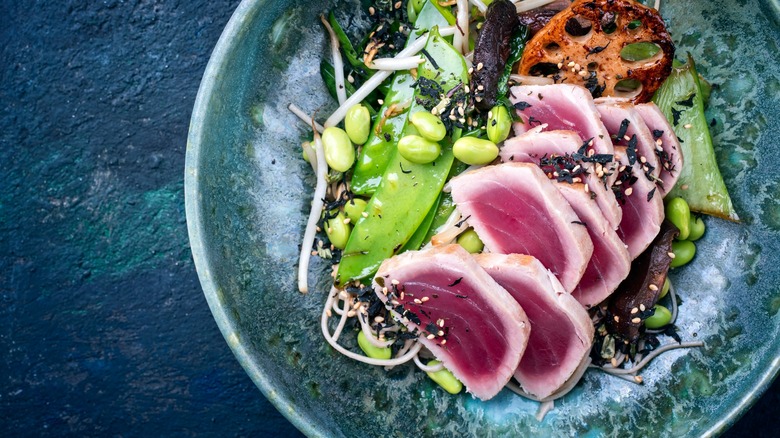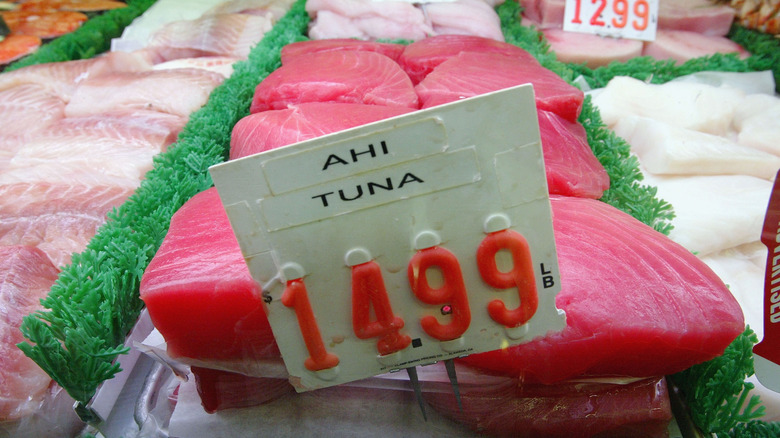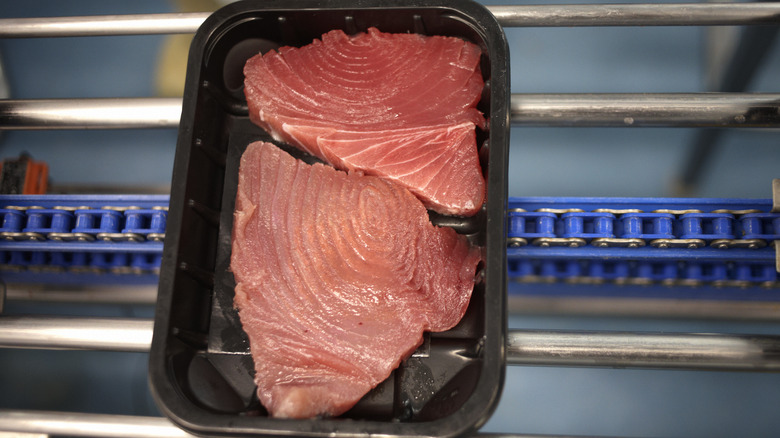What Is Ahi Tuna And How Is It Different From Other Tuna?
For decades, tuna, the so-called chicken of the sea, has been a staple food in many American households. While canned tuna products have long been the most popular, with numerous chefs even having their favorite canned tuna brands, many Americans are also turning toward fresh cuts of tuna, including ahi tuna thanks to its unique flavor and texture. However, despite its growing popularity, many people still don't know exactly what ahi tuna is, let alone what its characteristics are. With this in mind, we reached out to tuna expert and Director of Seafood Quality at Fulton Fish Market, Robert DiGregorio, asking him to enlighten us on all aspects of ahi tuna.
DiGregorio, otherwise known as Bobby Tuna, is a true expert, having worked at Fulton Fish Market since leaving the Marines in the 1970s. During his time there, DiGregorio has worked in many roles from fish cutter all the way up to his current position as Director of Seafood Quality. DiGregorio has specialized in tuna since the mid-1980s, and even wrote a comprehensive book on the topic, "Tuna Grading and Evaluation", the second edition of which was published in 2017. With decades in the business and millions of pounds of tuna sold by his hands, DiGregorio is the perfect person to dispel the ongoing confusion that surrounds ahi tuna.
What is ahi tuna?
The most important thing Robert DiGregorio tells us is that, contrary to what many people assume, ahi tuna is not an actual species. As he explains, "It is an Hawaiian word that refers to both Yellowfin and Bigeye Tuna, Thunnus albacares and Thunnus obesus, respectively. Both types are known for their use in raw preparations like sashimi and poke due to their firm texture and mild flavor."
While sharing the same name, these two species have distinct differences. Yellowfin tuna are easily distinguishable from other closely related fish by the streaks of yellow that mark their body and fins. Bigeye tuna are of a similar size to yellowfin, often growing to around six feet in length and reaching weights of over 450 pounds. They're recognizable by their metallic blue backs and upper sides and, as the name suggests, they have larger eyes than several other tuna species, including the yellowfin. Differences are also found between the two species' flesh. DeGrigorio mentions, "Yellowfin is typically a lighter red color, a bit firmer and milder. Bigeye have a higher fat content and rich texture."
The term ahi, meaning "fire," was first given to yellowfin by Hawaiian fishermen because the fish moved fast enough to cause the wood where fishing lines met the boat to smoke. It is not known when the term was also used to describe bigeye tuna but it is widely accepted that yellowfin were the first species to have the name ahi.
How is ahi tuna caught?
How ahi tuna is caught varies depending on where in the world the fishery is located. In our interview, Robert DeGrigorio explained, "Tuna is caught all over the world by different methods. In the U.S. commercial tuna fisheries, the best Bigeye and Yellowfin are mainly taken by longliners or by hook and line. Albacore are mainly taken by trolling or hook and line. The best Bluefin are taken by rod and reel."
While they sound similar, the fishing techniques DiGregorio described are actually very different from one another. Hook and line is the technique most of us associate with fishing; a baited, hooked line is attached to manually operated fishing poles with the goal of catching naturally schooling fish. Trolling is a technique where baited, hooked lines are drawn through the water at low speeds in order to attract larger fish. Finally, longlining involves trailing a mainline, which can be miles long, behind a boat with branch lines bearing baited hooks attached to it.
While many species of tuna are caught using the same techniques, the equipment used to bring them in varies. This is no truer than in hook-and-line fishing. For large bluefin tuna, exceptionally strong, flexible poles and large capacity reels have to be used in order to withstand the immense strength of these animals. While strong, ahi tuna do not place the same demands on equipment, so less specialist rods and reels can be used to bring them in.
Is ahi tuna more sustainable than other types of tuna?
Sustainability is something that is at the forefront of many consumers' minds. This is especially true when it comes to fish, a food that's famously difficult to trace through food systems. Robert DiGregorio offered us some reassuring words."Tuna is one of the most regulated fish in the world," he explained. "According to NOAA, Yellowfin and Pacific Bigeye are not overfished and are not being overfished. Atlantic Bigeye is also not being overfished. Albacore is in good supply and not overfished."
It's harder to determine the sustainability of tuna fisheries outside of United States waters. For example, the status of yellowfin tuna fisheries in the Indian Ocean is much more obscure, leading some to worry that it is being overfished. This sentiment is backed up by some data. A study published in Ocean & Coastal Management even suggests that there has been a 70% drop in yellowfin tuna biomass in the Indian Ocean, marking this stock as decidedly unsustainable.
Of course, sustainability is affected by how the fish is caught, not just where. A great example of this is longlining which, unless carefully managed, can result in a lot of by-catch and have detrimental effects on marine wildlife, including seabirds. As it can be hard from a consumer's perspective to determine if careful management practices have been put in place, the easier and most sustainable option is to seek out hook-and-line caught tuna to purchase.
What does ahi tuna taste like?
The meat of yellowfin and bigeye vary in both flavor and texture as well as appearance. As Robert DiGregorio highlighted to us, "Yellowfin has a mild, slightly sweet flavor with a firm texture and Bigeye tends to have a slightly richer taste due to its higher fat content." This isn't to say yellowfin lacks flavor. It actually has a much more pronounced taste than several other tuna species — including albacore, the flesh of which is very mild. This pronounced but not overwhelming flavor makes yellowfin very versatile.
Bigeye, on the other hand, is most definitely a fish that's suited to sushi. Its oily, rich, and meaty characteristics make it a favorite of sushi and sashimi lovers the world over. Those who want a more delicate flavor should opt for akami, tuna that's cut from the top of the loin. This is less fatty than the other cuts, making it a milder mouthful.
Of course, rich as it is, bigeye is far milder than bluefin tuna which is succulent and buttery; excellent bluefin is said to melt in the mouth. These characteristics have seen it become the ultimate fish in sushi and sashimi circles, with perfect specimens fetching well over $1 million at market. However, such a reputation has taken its toll and several bluefin populations are declining — or have already declined — as a result of overfishing. In fact, many grocery store brands, including Costco, won't stock bluefin for this very reason.
How to cook with ahi tuna
Given that all types of tuna, yellowfin and bigeye included, have different fat contents, flavors, and textures, it should come as no surprise that all require slightly different approaches when being cooked. Despite this, Robert DiGregorio has some advice that is applicable to both yellowfin and bigeye. In our interview, he said, "Ahi tuna is versatile and while I may not be a chef, I personally find that simple preparations seem to enhance fish the best and that the most important thing is not to overcook [the fish]."
The importance of not overcooking tuna cannot be overstated. The flesh of the fish is not like beef, which contains a great deal of fat and connective tissue that breaks down during cooking and moistens the meat. Due to a lack of fat and connective tissue, tuna meat goes from moist and succulent to dry and crumbly in the blink of an eye. To prevent this from happening, many suggest searing tuna, especially yellowfin and albacore tuna steaks, at high temperatures and for short periods of time. Fattier fish, including bigeye and bluefin, are slightly more robust but should also be cooked quickly and over high temperatures.
Fattier fish are also suited to other preparation methods, including dry-aging. While not technically cooking, this preparation method is known to deepen the flavor of tuna like bigeye, making it perfect for sashimi, sushi, and even poké bowls, based on a Polynesian dish with ancient origins.
Where to buy ahi tuna
Both yellowfin and bigeye tuna can be purchased online. Several retailers, such as Fulton Fish Market and Riviera Seafood Club, sell and ship premium tuna to customers' doors. The fish is usually frozen. However, Robert DiGregorio explained that, despite widely held misconceptions, frozen fish is just as good, if not better, than fresh. As he explained, "Exceptional frozen seafood begins with selecting high-quality seafood and then rapidly freezing the seafood shortly after harvest." He elaborated further, saying, "In fact, many sushi restaurants, from take-out spots to Michelin-starred establishments, rely on frozen seafood for its exceptional benefits."
When it comes to national grocery stores, frozen yellowfin is often stocked at reasonable prices. For example, Target sells a 16-ounce packet of wild-caught yellowfin tuna steaks for $7.99 under its Good & Gather private label. Bigeye tuna is harder to find, although some retailers like H-E-B do stock the fish in certain stores. The same can be said of canned tuna; yellowfin is much easier to find, being stocked in retailers such as Walmart. Of course, fresh filets of both species should be available from local fishmongers if you happen to live on or near either the Pacific or Atlantic coastlines.
How to store ahi tuna
As with any fresh fish, ahi tuna needs to be stored correctly so it doesn't go bad. Fortunately, Robert DiGregorio explained exactly how to do so, saying, "Fresh ahi tuna should be stored in the coldest part of the refrigerator and used within 1-2 days. For longer storage, it can be vacuum-sealed and frozen for up to 3 months. When freezing, ensure it's wrapped tightly to prevent freezer burn and preserve its quality."
In comparison, cooked ahi tuna can be stored in the fridge for three to four days. Cooked tuna can also be frozen. Again, this cooked fish should be wrapped to prevent it from developing freezer burn. In this state, it lasts for about three months.
Frozen ahi tuna, both cooked and raw, must be defrosted properly before being cooked or reheated. The best method for doing this is to place the frozen fish in the refrigerator and allow it to defrost slowly over a 24 hour period.
